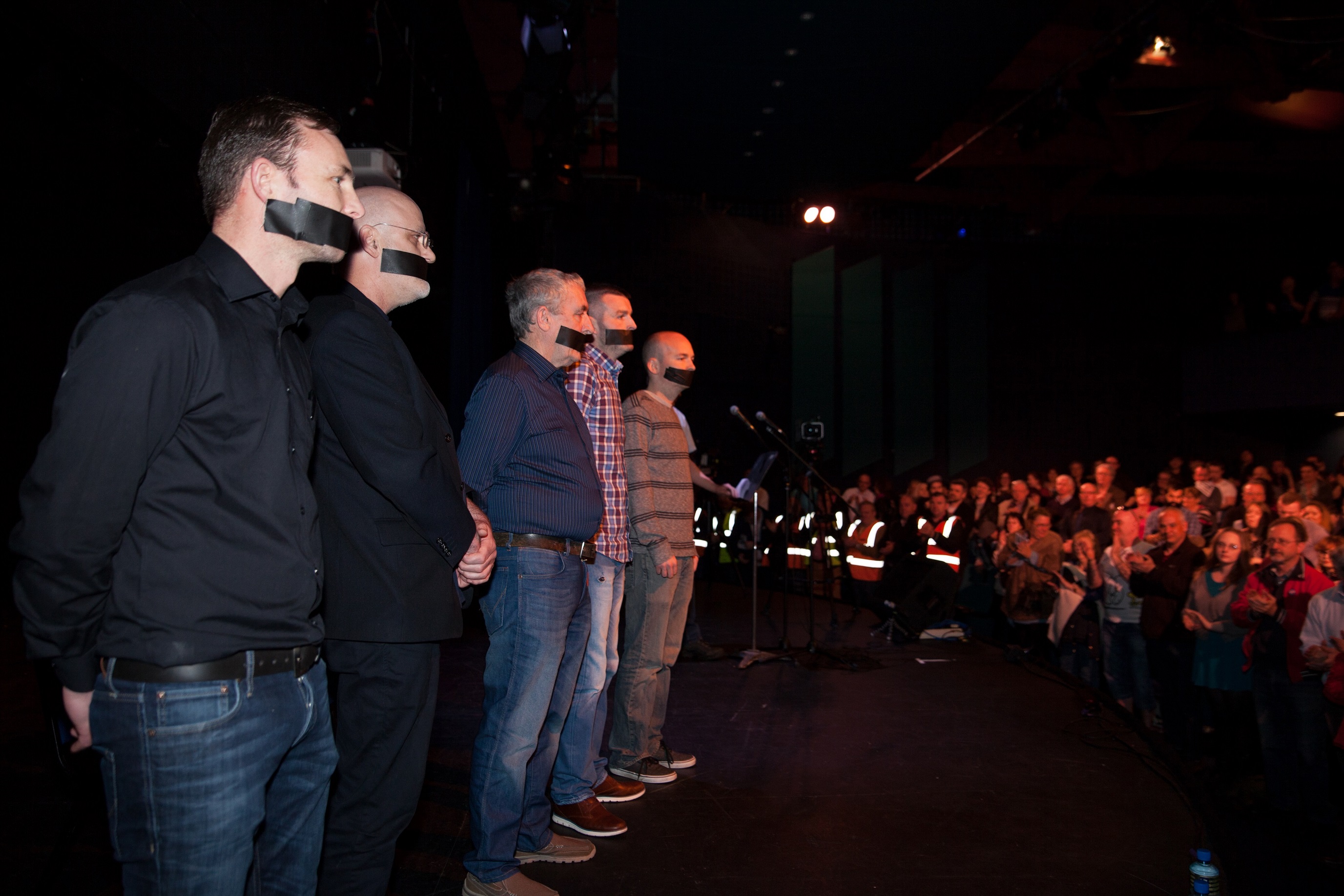Despite a jury finding protestors innocent of charges relating to a high profile anti-water charges protest in 2014, the media took a different view. Henry Silke reports.
Since the 1960s, the media’s coverage of protests and protest movements has been the focus of many studies. The US Anti-Vietnam War movement was among those initially studied, with the findings including that journalists tended to look for, and often found, violence at protests.
Whether this was done for merely sensationalist reasons or otherwise, the outcome had obvious political consequences; protesters are portrayed as a mob, violent discontents who have to be controlled by police and the wider establishment to protect society.
The politicised and partisan approach of much mainstream journalistic coverage of the recent mass movement against water charges in the Republic of Ireland has, it can be argued, taken a similar approach. However, rather than bolster the establishment position, it seems to have fed into the decreasing public credibility of the mainstream media.
Thousands of videos and blogs have been shared across social media challenging the attempt by many in the media to portray the anti-water charges movement as violent.
This may be due to two reasons; firstly, the anti-water charges movement was a real spontaneous mass movement with numerous marches involving tens and often hundreds of thousands people, alongside hundreds of local groups engaged in various activities. This means that hundreds of thousands of people and their families have direct experience of the movement.
Secondly, media has lost its monopoly of distribution and broadcasting. Thousands of videos and blogs have been shared across social media challenging the attempt by many in the media to portray the anti-water charges movement as violent.
A study in detail of an aspect of one of the key media incidents of the Irish Water controversy, the protest against the then Minister for Social Protection, Joan Burton TD, in Jobstown in West Dublin in November 2014 can be utilised to highlight a wider pattern of coverage by the media of this protest movement.
On the Minister’s arrival to confer awards at an adult education ceremony in the working class area, locals staged a spontaneous protest, finally leading to a sit-down in front of her car which lasted approximately two hours. The protest included the hurling of at least one water balloon and much abuse. No protester was arrested or detained on the day.
In one particularly hyperbolic article, the Irish Daily Mail compared the Minister’s ordeal to that of two British soldiers that had been killed by the Provisional IRA after driving into a funeral in the 1980s. The press in general described protesters as ‘a mob’, their actions as ‘violent’ and ‘anti-democratic’, and there was also a clear classist tone to much of the coverage. In a bizarre incident the protesters were even compared to ISIS by one government backbencher.
A major investigation was launched by the Gardai into the event, which included the establishment of an incident room and dedicated team of investigators. This led to the arrest, months later, of 27 people on a variety of charges including ‘violent disorder’ and ‘criminal damage’. 13 of the activists were charged with ‘false imprisonment’, a charge that could theoretically lead to life imprisonment. The recently elected Solidarity TD Paul Murphy, who had taken part in the protest, was awoken before dawn by police and arrested. Two other local Solidarity politicians were also arrested. One 14-year-old protestor was arrested by eight Gardai.
It should be noted that during the protest the Minister was surrounded by police the entire time and was never in any obvious physical danger. In fact, in footage from a police helicopter the police are heard saying that a jeep in which the Minister was situated could have “went backwards ages ago, but they seemed to not want to do that”.
The first seven adults accused of falsely imprisoning the Minister endured a full jury trial lasting over 40 days in June 2017, where six defendants were found not guilty and the seventh had the charges against him dropped. The immediate press coverage of the trial outcome was bizarre, with the Irish Times editorial on 30th June concentrating on the issue of people tweeting from the courthouse rather than the political aspect of the trial itself, nor the fact that the judge had cast doubt on the veracity of no less than 180 police statements.
Claims of overreach on the part of the prosecution were repeated and editorials and opinion pieces continued to use pejorative terms such as ‘mob’ even after the ‘not guilty’ verdict. Moreover, a theme followed in many stories was that the defendants were only found not guilty due to erroneous reasons, such as supporters tweeting from court, or mistaken strategies by the prosecution rather than the fact that it had been a largely peaceful protest and the Minister had not been ‘falsely imprisoned’.
An analysis of 154 articles relating to the case published in Irish newspapers between the 25th April and 6th July indicates the scale of the bias evident in the reporting.
Firstly, on the court reporting, that is non-editorialising articles that should in theory be straight reporting, without opinion. In total, there were 83 such articles, of which 21 focused on both prosecution and defence arguments, 33 focused on the prosecution case and 29 focused mainly on the defence case. On surface view this is relatively even, however when we look at the word count, that is the length of the articles, we find that that articles with a focus on both cases make up 7,940 words or 21% of the coverage, articles focusing on the defence make up 12,279 words or 32% of the articles, but articles focused on the prosecution side make up almost half of the total coverage with 17768 words or 47% of the total word count.
Moreover, articles focusing on the prosecution case had far more dramatic and emotive headlines, often quotes, such as ‘‘ ‘I was running for my life,’ Burton tells Jobstown trial”. Whereas defence centered articles tended not to, apart from two articles describing
the arrest of one defendant, “protester cuffed in front of child” (Irish Daily Mail, 31st May). The focus of the articles could be explained by the fact that the prosecution arguments by their very nature were more exciting and emotive and editors will naturally forefront such stories, however the word count issue is less defensible.
A far greater issue of the coverage was that of the editorialising articles on the Jobstown incident and trial, that is feature-based or opinion articles that are not objective but give the view of the journalist or commentator. Here a substantial bias is found. In all, 16 articles (published between 1st July and 6th July) were found, of these 14 very clearly argued against the defendants and in many cases argued the defendants were in fact guilty, if not of false imprisonment, then of any number of other offences:
“Paul Murphy and his acolytes were free to go, without a stain on their characters. But being innocent of this particular crime does not, however, mean they had done nothing wrong” (Mark Dooley, Irish Daily Mail, 1st July).
One article compared the sitdown protest to a scene in ‘The Handmaid’s Tale’ where characters are executed by public stoning
These articles were as hyperbolic as previous coverage of the Jobstown incident. For example, one article by Brenda Power compared the sit-down protest to a scene in ‘The Handmaid’s Tale’ where characters are executed by public stoning (Irish Daily Mail, 4th July). Other issues raised were denouncements of ‘hard’ left politics, for example an article written by Joan Burton’s ex-chief of staff, denounced Trotskyism (Sunday Independent, 2nd July) branding Solidarity ‘the forces of darkness’ and according to Daniel McConnell (Irish Examiner, 1st July): “…if Mr Murphy, Mr Barry, or Ruth Coppinger wish to claim victory for what Jobstown was, then they have shown why they are genuinely unfit to hold public office”.
Eilis O’Hanlon, in the Sunday Independent returned to the trope of the ‘sinister fringe’ and in a classic example of news construction, that is the constructing of a news frame, repeated continuously until it becomes ‘fact’. O’Hanlon stated:
“There was an ugly mood in the air during 2014 and 2015. Protests against water charges had escalated into a rowdy free-for-all, in which the threat of violence lurked menacingly beneath the surface”. (Sunday Independent, 2nd July)
None of which is borne out in fact, as throughout the numerous mass demonstrations, and the clear majority of smaller demonstrations, incidents of even minor violence were extremely rare.
Another columnist for the Irish Examiner, Fergus Finlay (Irish Examiner, 4th July), mocked any idea of a there being any political issue to the trial, and compared Paul Murphy to Donald Trump because both “talk about right-wing media conspiracies”. This is an interesting and rhetorical tactic, common in the coverage; criticism of the media coverage of an event is dismissed as ‘conspiracy theories’. This reduces critique of media and journalism to a simplified organised conspiracy, rather than the much more nuanced area of political economy, power, ideology and discourse uncovered by decades of research into to the area.
In contrast, only two articles made arguments close to supporting the defendants, or at least not denouncing them outright. Fintan O’Toole in the Irish Times on 4th July, argued that the trial was not political in an overt sense but rather part of the structural class relations within Irish society:
“There is a much more obvious explanation for why people in Jobstown would be subjected to dawn raids on their homes, handcuffed and hit with ludicrously over-the-top criminal
charges carrying penalties up to life imprisonment. It’s social class”
Martina Devlin in the Irish Independent on 1st July argued that there was neither kidnapping nor rioting in Jobstown on the day and that the DPP and “the State lost some of its authority by pressing such an unlikely and intemperate charge against the deputy and five other men”.
In total, the anti-Jobstown defendants editorialising articles made up 15,349 words, or 89%, or such coverage, while the two articles that didn’t attack the defendants made up 1,947 words or 11% of the articles.
Post-trial, several issues became evident. These were counted in standalone articles on the issues (it should be noted these issues were also covered in the editorialising feature articles on the trial, therefore should not be read as definitive numbers but rather an indication of their importance).
Firstly, the issue of the role of social media which was found in 13 standalone articles. Here there was much disquiet on the reporting of the trial via social media, including The Independent in an article headlined “Trial will speed up moves to regulate the use of social media during court cases” (Irish Independent, 30th June). Other articles discussed the issue of the Twitter campaign #jobstownnotguilty and what they termed biased online reporting of the case by the defendants supporters, which is strictly illegal under Irish law during a trial. However, none of these articles seemed to consider the effect of media reporting on the case at the time of the incident, which as discussed was often biased against the defendants in the most hyperbolic fashion.
The second major issue was the question of whether the trial was political or not. This issue was covered in opinion articles with the vast majority considering the issue of a political ‘conspiracy’ against the defendants as having no basis in fact. In nine reports, six led with defendants accusation of the trial having a political element and three leading with denials of same. The issue of whether the defendants were ‘overcharged’ was found in five articles. It’s worth pointing out that in many articles the problem with the defendants being overcharged of false imprisonment was not seen as a problem with the overcharge itself, or a moral issue of any potential of miscarriage of justice with political implications but rather as a strategic issue, that is the State should have pushed for lesser charges that there was more likely to have been a conviction on. Problems with Garda evidence was the issue of five articles and TDs fearing for future safety was the issue of two articles.
The analysis of the aftermath of the Jobstown trial would seem to confirm a stark media bias against the protestors. There also emerged a key establishment concern over the bypassing of the “responsible media” by discourse on social media. That this highlighted clear bias on the part of the media was not the issue rather it was how could social media be greater controlled.
The approach of the State and mainstream media to both these issues which were highlighted by the Jobstown trial should be of concern to all progressive political and trade union activists, whatever their view of the Jobstown protest.





